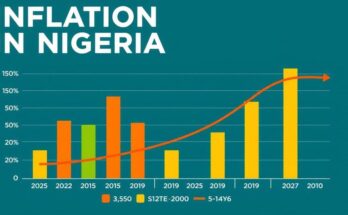Sudan’s inflation rate fell to 145.14% in January 2025 from 187.83% in December. This decline marks a continued downward trend in inflation rates throughout late 2024. All states reported decreases in inflation, with the urban rate at 124.26% and the rural rate at 159.66%. Many citizens struggle with high prices and necessitate humanitarian aid amid ongoing conflict.
As of January 2025, Sudan’s inflation rate has decreased to 145.14%, down from 187.83% in December 2024, according to the Central Bureau of Statistics. This decline in inflation reflects an ongoing trend; rates previously stood at 198.22% in November and 211.48% in October. The figures indicate a notable relief for consumers who have been facing soaring prices during the economic crisis.
The Central Bureau of Statistics reported that inflation in urban areas reached 124.26% in January, a decrease from December’s rate of 158.62%. In rural regions, the inflation rate was 159.66%, down significantly from 207.17%. The reduction in inflation was consistent across all 18 states, with West Darfur experiencing the largest decline at 170.13%, followed by Gedaref at 147.40%.
The Central Bureau of Statistics uses a comprehensive methodology by tracking 663 commodities across various social, economic, and geographical contexts to gauge inflation. These commodities fall into 12 categories, including essential items such as food and beverages, housing, and healthcare. Sudanese households allocate an increasing portion of their income to basic needs, spending approximately 52.89% on food alone.
Many Sudanese citizens are currently struggling due to ongoing conflict, which has disrupted livelihoods and led to a significant demand for humanitarian aid. The United Nations estimates that around 30.4 million people, accounting for 64% of Sudan’s population, require assistance. The challenging economic landscape continues to exert pressure on families as they navigate high living costs.
In summary, Sudan’s inflation rate has shown a downward trend, dropping to 145.14% in January 2025 from previous months. Despite this decrease, many Sudanese citizens continue to face economic hardships due to high prices and ongoing conflicts that have disrupted livelihoods. Consequently, a significant portion of the population is in need of humanitarian assistance, illustrating the profound impact of these economic challenges.
Original Source: sudantribune.com




